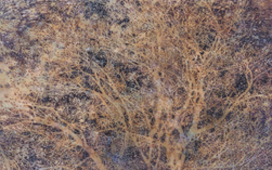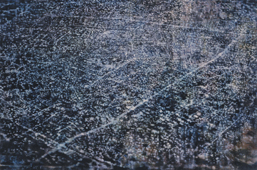
- "a thousand years 160~255cm"
- - Nature Series -
-
Masako Yasuki has been painting "landscape" throughout her career.
Her "landscape" is, however, not the same as the "landscape" that we witness.
Consequently, question after question flows through our minds: How do we recognize the "landscape" floating around us as nothing other than "landscape" , and how can the "landscape" convince us as such? We never have doubt that what we see is "landscape," but how can it be so? What does the "eye" actually "see" ? How does the "eye" tell the "hand" of a painter to paint a "painting" ? Does the "hand" actually "see"? etc... Yasuki, so to say, has been painting a picture of this everlasting queue of questions. Yes, her painting is the "landscape of questioning.
The word "questioning" has two different meanings, one of which is "to question" (as a gerund or as a noun)and the other"to be posing a question at the very moment" (as a present participle). Yasuki's "questioning" contains both.
Nagahiro Kinoshita

- "Obliterated Ground 200~300cm"
- - Obliterated Ground -
-
This painting belongs to one of the biggest series by Masako Yasuki namedeObliterated Groundf, which deals mainly with Japanese cities that were bombed and destroyed during World War2. Although the artist chooses not to identify them, all the cityscapes are based on real locations.
Yasuki creates, for example, this painting from her memory of a view from a hill above a strategic target of U.S. air raids and photographs of the city taken after the war.he also efrottages' the actual ground of the city with charcoal and uses those images as well as the asphalt or clod from the city as part of her material,which she builds in three different layers, using a combination of Japanese and Western techniques.
According to the painter, gI started this series to represent some sort of gap between historical images or knowledge and memorycand the physical world we really face, the actual landscape in front usch
From Collecting Art of Asia Catalogue (Linda Muehling) 
- gPine woods"900cm x 600cm"
- - Gold Series -
-
I consistently deal with glandscapeh in my work. For some time I have been trying to create paintings capable of suspending the passage of time, the human perception of things, and the mechanisms of memory in order to liberate them from their contexts. I paint with egg tempera and oil using techniques and mediums that can be tracked back deep into Western art history, and combine these materials with Gofun (Paris white) and rock pigment, which are characteristic of the Oriental painting tradition. I aim at reexamining the concept of time and the perception of things rooted inside of me, an individual who was born and brought up in Eastern culture.
Though based upon Western painting methodology, I have long and naturallybeen intrigued by Japanese screen paintings, not least because living in Kyoto provides me with a lot of opportunities to see actual masterpieces. Therefore, the use of gold leaf in my painting is important in that it reconnects me with the painting method and media of, or instance, the masters of the Kanoh School and Hasegawa School; that is, in short, with the core of Japanese art history.
I want to present my work as detached from the narratives and stories educed from depicted images, and from the symbols and messages inherent in the use of gold. I hope my painting shifts and shakes, even if just a bit, our bodily sensation and perception of time,space, or even the society and the world surrounding us.
Masako Yasuki@(from GOLD EXPERIENCE catalogue) - - Pine Trees -
-
In Japan, pine trees are often planted along the boundaries of humanity's sphere of influence, demarcating borders between controlled and uncontrolled territories, mapped and uncharted regions, secular and sacred realms...
Let us take with equanimity the wild leap into the unknown tha is life in this world. And let us not blindly destroy ourselves. May human history yet travel far into the unseen.
Masako Yasuki@(May,2020)
Notes
© MASAKO YASUKI All rights reserved.